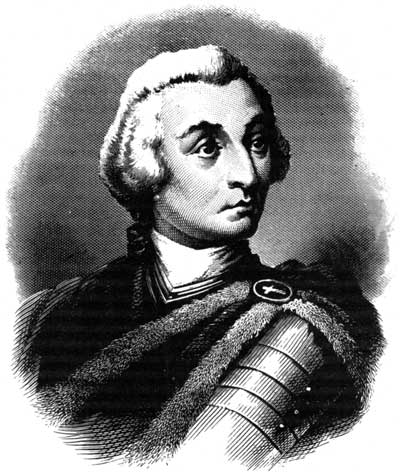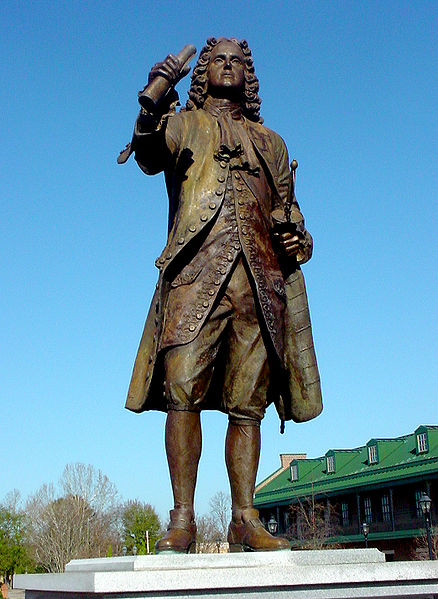<Back to Index>
- Mathematician Srīnivāsa Aiyangār Rāmānujan, 1887
- Dramatist Jean Racine, 1639
- Founder and Governor of Georgia James Edward Oglethorpe, 1696
PAGE SPONSOR


James Edward Oglethorpe (22 December 1696 – 30 June 1785) was a British general, a philanthropist, and was the founder of the colony of Georgia. As a social reformer in Britain, he hoped to resettle Britain's poor, especially those in debtors' prison, in the New World.
Oglethorpe was born and raised in London, the son of Sir Theophilus Oglethorpe (1650 - 1702) of Westbrook Place, Godalming in the county of Surrey. Oglethorpe entered Corpus Christi College, Oxford in 1714, but in the same year left to join the army of Prince Eugene of Savoy. Through the recommendation of John Churchill, 1st Duke of Marlborough, he became aide-de-camp to the prince, and during the Austro-Turkish War of 1716–18 he served with distinction in the campaign against the Turks during 1716-17, particularly at the siege and capture of Belgrade. After his return to England he was elected as a Tory Member of Parliament for Haslemere in 1722. He campaigned for the improvement of the circumstances of poor debtors in London prisons. For the purpose of providing a refuge for people who had become insolvent and for oppressed Protestants on the continent, he proposed the settlement of a colony in America between South Carolina and Spanish-held Florida.
Oglethorpe sailed for 88 days, arriving in Charleston, South Carolina on the ship Anne in late 1732, and settled near the present site of Savannah, Georgia, on February 12, 1733. He negotiated with the Creek tribe for land and established a series of defensive forts, most notably Fort Frederica, of which substantial remains can still be visited. He then returned to England and arranged to have slavery banned in Georgia. Oglethorpe and his fellow trustees were granted a Royal Charter for the Province of Georgia between the Savannah and Altamira rivers on June 9, 1732. Georgia was a key contested area, lying in between the two colonies. It was Oglethorpe's idea that British debtors should be released from prison and sent to Georgia. Although it is often repeated that this would theoretically rid Britain of its so-called undesirable elements, in fact it was Britain's "worthy poor" whom Oglethorpe wanted in Georgia. Ultimately, few debtors ended up in Georgia, the colonists included many Scots whose pioneering skills greatly assisted the colony, and many of Georgia's new settlers consisted of poor English tradesmen and artisans and religious refugees from Switzerland, France and Germany, as well as a number of Jewish refugees. The colony's charter provided for acceptance of all religions except Roman Catholicism. The ban on Roman Catholic settlers was based on the colony's proximity to the hostile settlements in Spanish Florida.
On 21 February 1734, Oglethorpe established the first Masonic Lodge within the British Colony of Georgia. Now known as Solomon's Lodge No. 1, F. & A. M. it is the "Oldest Continuously Operating English Constituted Lodge of Freemasons in the Western Hemisphere". For a period in 1736, Oglethorpe's secretary was Charles Wesley, later well known as a hymn writer of Methodism.
Owing to the colony's primary role as a military buffer between English and Spanish-held territories, the original model for the colonisation of Georgia excluded the use of slave labour, fearing that runaway slaves could internally weaken the colony and assist the enemy at St. Augustine. But, instead of slaves defecting southwards to the Spanish, runaways from the Carolinas found refuge in Georgia, thus irritating its northern neighbour. The banning of slavery also reduced the work force, and this was felt to be a constraint on Georgia's early economic growth. Many settlers thus began to oppose Oglethorpe, regarding him as a misguided and "perpetual dictator". Many new settlers soon set their eyes on South Carolina as a less restrictive and, they hoped, a more profitable place to settle. In 1750, after Oglethorpe had left the colony, the ban on slavery was lifted, and large numbers of slaves were soon imported.
In 1735, Oglethorpe visited Britain taking with him a delegation of Cherokee who met George II and his family at Kensington Palace. Oglethorpe was widely acclaimed in London, although his expansionism was not welcomed in all quarters. The Duke of Newcastle who
directed British foreign policy, had tried to restrain Oglethorpe's
efforts in the colony for fear of offending the Spanish, who Newcastle
wished unsuccessfully to court as an ally. Newcastle eventually
relented, and became a supporter of the colony admitting "it will now
be pretty difficult to give up Georgia". The colony was one of three major disputes which worsened Anglo-Spanish relations in the late 1730s. In 1739, during the War of Jenkins' Ear, fought between British Georgia and Spanish Florida as part of a larger conflict, the War of Austrian Succession, Oglethorpe was responsible for a number of successful raids on Spanish forts, as well as the unsuccessful Siege of St. Augustine.
Although Oglethorpe failed in his attempt to capture St. Augustine,
there is a view among some historians that the strike deep into Spanish
Florida succeeded in placing the Spanish on the defensive for several
years, and that Oglethorpe's decision not to order an all-out assault
on the city saved British lives. The invading force represented a large
percentage of the total male British population of Georgia, and
significant losses would have been a huge blow to the colony. Among
Oglethorpe's most valuable Indian allies in this siege was Mary Musgrove.
Her Indian name was Coosaponakeesa (lovely fawn), and she was married
to John Musgrove, a trader. Following the failed attempt to strike
against Florida, Oglethorpe commanded British forces during the Spanish invasion of Georgia, defeating them at the Battle of Bloody Marsh and forcing them to withdraw.
After
his exploits in Georgia, Oglethorpe returned to London in 1743 and rose
steadily through the ranks of the British Army. There is some evidence
that he returned to Europe under a pseudonym, with the assistance of Field Marshall Keith (a
distant relative who is said to have died in battle in Oglethorpe's
arms). His private means at this time included an estate at Putney, and
emoluments gained through his marriage to Elizabeth Wright, Lady of the
manor of Cranham Hall (Cranham, Essex, England), although not before a pre-nuptial agreement protecting her property rights. These were the days of the "Young Pretender" and incursions by the Jacobite troops from Scotland into the North of England.
Oglethorpe had been busy forming a unit of Rangers which were to be
shipped out to defend Georgia from future Spanish attacks. He
immediately put his troops at the disposal of the government forces,
under the command of the Duke of Cumberland, who were attempting to suppress the rebellion. Oglethorpe and his troops joined with Cumberland at Preston and attempted to harry the retreating Jacobite army as they tried to escape back to Scotland. He fought a skirmish at Shap Fell in Cumbria,
but he was forced to break off the engagement by the intense weather
and take shelter for the night. Overnight the Jacobites managed to
withdraw and escape over the fell. Because of this Oglethorpe was
court-martialled on the accusation of not pursuing the invaders more
aggressively; he was acquitted, attained the rank of General, but never again given a command. Although a strong supporter of the British war effort in the Seven Years War, Oglethorpe took no active role in the conflict. In 1785, Oglethorpe visited John Adams (the first US minister plenipotentiary to the Court of St. James's, i.e., the first US ambassador to Britain)
shortly after the latter arrived in London. The meeting included an
expression by Oglethorpe of his sadness of the ill-will that had
existed between the countries, and it is suspected that his time in
Georgia dealing with a recalcitrant British Government could have led
to Oglethorpe's empathy with the revolutionaries. Although notes were compiled, Johnson failed to complete a biography of the General. Oglethorpe died at Cranham in 1785, and was buried at the centre of All Saints' parish church which immediately adjoins Cranham Hall (rebuilt
c. 1790, but sketched prior by John Pridden in 1789). Elizabeth
survived him a few years and was subsequently buried at his side. In
the 1930s an exploration of their vault was made by the then President
of Oglethorpe University, Atlanta, although permission to remove relics
to the University's chapel in Oglethorpe's colony was denied by the
Archdeacon. While All Saints' was also rebuilt c.1871, the new building
reused the foundations of the old one, and it was specifically noted
that, amongst others, Oglethorpe's memorial was replaced in its former
location, on the south wall of the chancel, where it may be seen today.
Oglethorpian anniversaries have since led to the donation of the altar
rail in All Saints' by a ladies charity in Georgia, and a visit to All
Saints' by the then Georgia Governor Zell Miller. Oglethorpe University, in Atlanta, Georgia, is named after James Edward Oglethorpe. A character based on James Oglethorpe plays an important role in The Age of Unreason, a series of four alternate history novels written by American science fiction and fantasy author Gregory Keyes. Historical novelist F. van Wyck Mason published a novel, Rascal's Heaven (1964)
about the founding of the colony of Georgia. Oglethorpe makes several
brief but significant appearances as a character in the story. Primary schools are named after James Oglethorpe both in Savannah, Georgia, and Cranham, Essex, England, his burial place.